Okay, so basically, we can break down the problem to basic issues:
- Get the angle between the two circles
- Draw a line from circumference of one circle to another along this angle
Both these issues aren't hard to solve (and any time spent searching the internet would provide solutions - because that's where I got them from ;))
So, the angle between two points could be calculated using something like...
protected double angleBetween(Point2D from, Point2D to) {
double x = from.getX();
double y = from.getY();
// This is the difference between the anchor point
// and the mouse. Its important that this is done
// within the local coordinate space of the component,
// this means either the MouseMotionListener needs to
// be registered to the component itself (preferably)
// or the mouse coordinates need to be converted into
// local coordinate space
double deltaX = to.getX() - x;
double deltaY = to.getY() - y;
// Calculate the angle...
// This is our "0" or start angle..
double rotation = -Math.atan2(deltaX, deltaY);
rotation = Math.toRadians(Math.toDegrees(rotation) + 180);
return rotation;
}
And the point on a circle can be calculated using something like...
protected Point2D getPointOnCircle(Point2D center, double radians, double radius) {
double x = center.getX();
double y = center.getY();
radians = radians - Math.toRadians(90.0); // 0 becomes the top
// Calculate the outter point of the line
double xPosy = Math.round((float) (x + Math.cos(radians) * radius));
double yPosy = Math.round((float) (y + Math.sin(radians) * radius));
return new Point2D.Double(xPosy, yPosy);
}
Just beware, there's some internal modifications of the results to allow for the difference between the mathematical solution and the way that the Graphics API draws circles
Okay, so big deal you say, how does that help me? Well, I great deal actually.
You'd calculate the angle between the to circles (both to and from, you might be able to simple inverse one angle, but I have the calculation available so I used it). From that, you can calculate the point on each circle where the line will intersect and then you simply need to draw it, something like...
double from = angleBetween(circle1, circle2);
double to = angleBetween(circle2, circle1);
Point2D pointFrom = getPointOnCircle(circle1, from);
Point2D pointTo = getPointOnCircle(circle2, to);
Line2D line = new Line2D.Double(pointFrom, pointTo);
g2d.draw(line);
Runnable Example
Because I've distilled much of the calculations down to communalised properties, I've provided my test code as a runnable example. All the calculations are based on dynamic values, nothing is really hard coded. For example, you can change the size and positions of the circles and the calculations should continue to work...

import java.awt.Color;
import java.awt.Dimension;
import java.awt.EventQueue;
import java.awt.Graphics;
import java.awt.Graphics2D;
import java.awt.Shape;
import java.awt.geom.Ellipse2D;
import java.awt.geom.Line2D;
import java.awt.geom.Point2D;
import java.awt.geom.Rectangle2D;
import javax.swing.JFrame;
import javax.swing.JPanel;
import javax.swing.UIManager;
import javax.swing.UnsupportedLookAndFeelException;
public class Test {
public static void main(String[] args) {
new Test();
}
public Test() {
EventQueue.invokeLater(new Runnable() {
@Override
public void run() {
try {
UIManager.setLookAndFeel(UIManager.getSystemLookAndFeelClassName());
} catch (ClassNotFoundException | InstantiationException | IllegalAccessException | UnsupportedLookAndFeelException ex) {
ex.printStackTrace();
}
JFrame frame = new JFrame("Testing");
frame.setDefaultCloseOperation(JFrame.EXIT_ON_CLOSE);
frame.add(new TestPane());
frame.pack();
frame.setLocationRelativeTo(null);
frame.setVisible(true);
}
});
}
public class TestPane extends JPanel {
private Ellipse2D circle1;
private Ellipse2D circle2;
private Point2D drawTo;
public TestPane() {
circle1 = new Ellipse2D.Double(10, 10, 40, 40);
circle2 = new Ellipse2D.Double(100, 150, 40, 40);
//addMouseMotionListener(new MouseAdapter() {
// @Override
// public void mouseMoved(MouseEvent e) {
// drawTo = new Point2D.Double(e.getPoint().x, e.getPoint().y);
// repaint();
// }
//});
}
protected Point2D center(Rectangle2D bounds) {
return new Point2D.Double(bounds.getCenterX(), bounds.getCenterY());
}
protected double angleBetween(Shape from, Shape to) {
return angleBetween(center(from.getBounds2D()), center(to.getBounds2D()));
}
protected double angleBetween(Point2D from, Point2D to) {
double x = from.getX();
double y = from.getY();
// This is the difference between the anchor point
// and the mouse. Its important that this is done
// within the local coordinate space of the component,
// this means either the MouseMotionListener needs to
// be registered to the component itself (preferably)
// or the mouse coordinates need to be converted into
// local coordinate space
double deltaX = to.getX() - x;
double deltaY = to.getY() - y;
// Calculate the angle...
// This is our "0" or start angle..
double rotation = -Math.atan2(deltaX, deltaY);
rotation = Math.toRadians(Math.toDegrees(rotation) + 180);
return rotation;
}
protected Point2D getPointOnCircle(Shape shape, double radians) {
Rectangle2D bounds = shape.getBounds();
// Point2D point = new Point2D.Double(bounds.getX(), bounds.getY());
Point2D point = center(bounds);
return getPointOnCircle(point, radians, Math.max(bounds.getWidth(), bounds.getHeight()) / 2d);
}
protected Point2D getPointOnCircle(Point2D center, double radians, double radius) {
double x = center.getX();
double y = center.getY();
radians = radians - Math.toRadians(90.0); // 0 becomes th?e top
// Calculate the outter point of the line
double xPosy = Math.round((float) (x + Math.cos(radians) * radius));
double yPosy = Math.round((float) (y + Math.sin(radians) * radius));
return new Point2D.Double(xPosy, yPosy);
}
@Override
public Dimension getPreferredSize() {
return new Dimension(200, 200);
}
protected void paintComponent(Graphics g) {
super.paintComponent(g);
Graphics2D g2d = (Graphics2D) g.create();
g2d.draw(circle1);
g2d.draw(circle2);
// This was used for testing, it will draw a line from circle1 to the
// drawTo point, which, if enabled, is the last known position of the
// mouse
//if (drawTo != null) {
// Point2D pointFrom = center(circle1.getBounds2D());
// g2d.setColor(Color.RED);
// g2d.draw(new Line2D.Double(drawTo, pointFrom));
//
// double from = angleBetween(pointFrom, drawTo);
// System.out.println(NumberFormat.getNumberInstance().format(Math.toDegrees(from)));
//
// Point2D poc = getPointOnCircle(circle1, from);
// g2d.setColor(Color.BLUE);
// g2d.draw(new Line2D.Double(poc, drawTo));
//}
double from = angleBetween(circle1, circle2);
double to = angleBetween(circle2, circle1);
Point2D pointFrom = getPointOnCircle(circle1, from);
Point2D pointTo = getPointOnCircle(circle2, to);
g2d.setColor(Color.RED);
Line2D line = new Line2D.Double(pointFrom, pointTo);
g2d.draw(line);
g2d.dispose();
}
}
}
Arrow head
The intention is to treat the arrow head as a separate entity. The reason is because it's just simpler that way, you also get a more consistent result regardless of the distance between the objects.
So, to start with, I define a new Shape...
public class ArrowHead extends Path2D.Double {
public ArrowHead() {
int size = 10;
moveTo(0, size);
lineTo(size / 2, 0);
lineTo(size, size);
}
}
Pretty simple really. It just creates two lines, which point up, meeting in the middle of the available space.
Then in the paintComponent method, we perform some AffineTransform magic using the available information we already have, namely
- The point on our target circles circumference
- The angle to our target circle
And transform the ArrowHead shape...
g2d.setColor(Color.MAGENTA);
ArrowHead arrowHead = new ArrowHead();
AffineTransform at = AffineTransform.getTranslateInstance(
pointTo.getX() - (arrowHead.getBounds2D().getWidth() / 2d),
pointTo.getY());
at.rotate(from, arrowHead.getBounds2D().getCenterX(), 0);
arrowHead.transform(at);
g2d.draw(arrowHead);

Now, because I'm crazy, I also tested the code by drawing an arrow pointing at our source circle, just to prove that the calculations would work...
// This just proofs that the previous calculations weren't a fluke
// and that the arrow can be painted pointing to the source object as well
g2d.setColor(Color.GREEN);
arrowHead = new ArrowHead();
at = AffineTransform.getTranslateInstance(
pointFrom.getX() - (arrowHead.getBounds2D().getWidth() / 2d),
pointFrom.getY());
at.rotate(to, arrowHead.getBounds2D().getCenterX(), 0);
arrowHead.transform(at);
g2d.draw(arrowHead);



